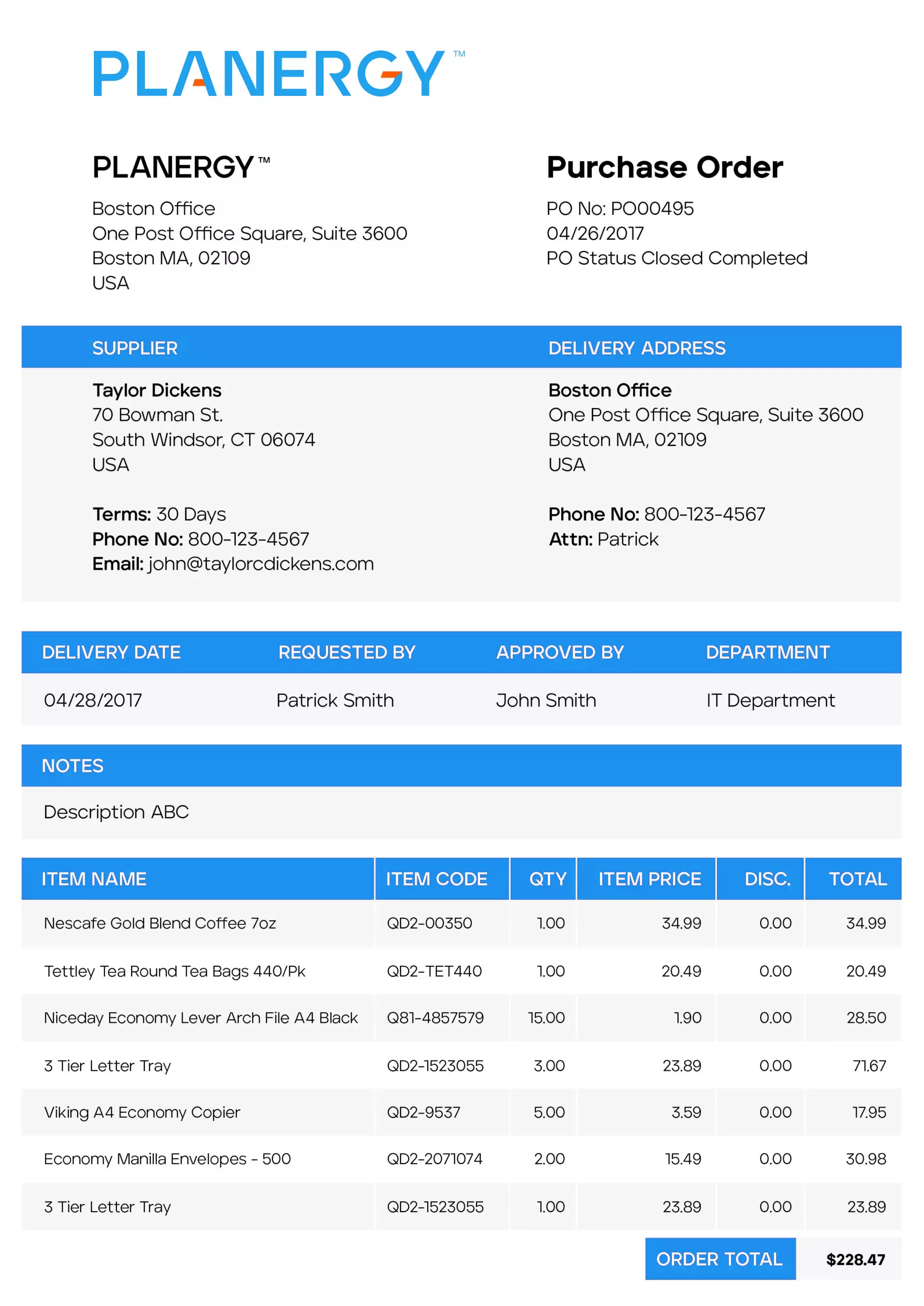A purchase order (PO) is a legal document that is created by a buyer and sent to a seller to confirm their intention to purchase products and/or services.
The PO document tracks important information related to what the buyer wants to purchase.
It includes the quantity and type of items required, as well as payment terms and delivery details.
The buyer is confirming what they want the seller to deliver. They are also agreeing to pay for the items at a later date (based on the agreed payment terms).
The seller uses the PO as protection when offering buyers credit because the buyer is legally obligated to pay for products and services when they have been delivered.
What Is The Purpose of a Purchase Order?
A purchase order is a legal agreement that protects both the buyer and the seller.
Once accepted by the vendor, a purchase order becomes a legally binding contract.
If there is not an existing contract that governs the relationship between buyer and seller, the purchase order can be used in place of a contract. This offers legal protection for both buyer and seller.
Using a PO also helps track the purchase through the full Procure-to-Pay process.
Each PO is assigned it’s own unique number, known as the purchase order number, to assist both buyer and seller in tracking delivery and payment of each purchase request.
There are various types of purchase orders, the most common are standard purchase orders and blanket purchase orders. Standard purchase orders cover a specific purchase with no recurrence.
Blanket purchase orders are used to commit buyers to purchase products or services on an ongoing basis until a certain threshold is reached.
Purchase orders serve as crucial documentation for auditing purposes, ensuring transparency and accountability in financial transactions within organizations.
They provide a clear record of agreed-upon terms, quantities, and pricing, facilitating efficient inventory management and budget allocation across departments.
How Does a Purchase Order Work?
For most organizations, the purchase order is the second step in the purchase order process.
It starts as a purchase order request, also know as a purchase requisition. To become a purchase order it must first get the correct approval within the buying company confirming the purchase should be made.
Normally this includes a review of the requirements as well as the cost against the remaining budget for the department the purchase relates to. But, for lower value orders there may be no additional approval required.
The purchase requisition form is a document similar to the purchase order that outlines what should be purchased, how many, where the purchase should come from, and so on.
But it is an internal document within the buying company and will not be shared externally.
Once approved, the purchase requisition coverts to a purchase order that can be sent to the supplier.
How to Use a Purchase Order
Purchase orders are used to simplify the procurement process. Here is a simple example of the PO process:
- A member of staff realizes that the office is low on stationary items and about to run out of printer ink. So they create a purchase request and send it to their manager for approval.
- The manager reviews and approves the purchases assigning a purchase order number.
- The purchase order is sent to the supplier, either on paper or using a dedicated electronic purchase order system.
- The supplier will review the purchase order and check their inventory to see if they have the required quantity of the requested items before accepting the PO.
- The supplier will ship the items to the buyer including the PO number on the packing slip as a reference.
- The supplier will issue an invoice, this should have a unique invoice number, requesting payment for the items and include the PO number on the invoice as a reference.
- The buyer pays for the items based on the agreed payment terms from the purchase order.
Once accepted by the vendor, a purchase order becomes a legally binding contract. If there is not an existing contract that governs the relationship between buyer and seller, the purchase order can take its place.
What Information is Needed on a Purchase Order?
A purchase order will contain the order details, this usually includes:
- The company name of the buyer
- Vendor information including the seller’s company name
- The product(s) or service(s) to be purchased
- Specifics of brand names, SKUs, model numbers, etc.
- Quantity purchased
- Price per unit
- Delivery date – when the order should be delivered
- Delivery location – where the order should be delivered to, or the shipping address, and relevant contact information
- Billing address – where the seller should send the invoice to after delivery
- Discounts – any discounts applied to the order per contract terms with the vendor
- Payment terms – when the invoice will be paid, such as on receipt of delivery, net 30 or net 60, or a specific due date – usually in line with the terms of the contract between the buyer and seller.

Pros and Cons of Purchase Orders
There are many reasons to use purchase orders. The most important reasons to use them include:
- Better accuracy in terms of financial and inventory management through better record keeping.
- Improved budgeting since funds must be available before issuing a PO.
- Faster delivery because POs help schedule delivery when the buyer needs it.
- Improved accounts payables processes and the ability to enforce compliance with 2- or 3-way matching.
That said, as with everything in life, there are some disadvantages.
- For smaller purchases, it adds paperwork.
- Credit cards can serve the same purpose from a financial point of view.
How Do I Start Using Purchase Orders
Small businesses often track purchase orders in an excel spreadsheet and use a basic purchase order form template to manually create the POs.
You can download templates for the PO and PO tracker and then customize these to suit your company.
Once you have the templates you can define a purchase order policy, this defines the process a PO should follow for approval.
Again, this might be very straightforward in a small business. For example, all orders above a certain value should be approved by the business owner.
But as a company grows it becomes more and more difficult to manage purchasing in this way.
To streamline the purchase process and automate the workflow, it makes the most sense to invest in an electronic purchase order system. This eliminates the need to rely on paper forms, which can easily be lost.
Electronic POs make it easier to get the necessary approvals from department heads before making the purchases.
Automation makes it possible to match the purchase order to the order delivery to the invoice in a process known as three-way matching.
This ensures you’re only paying for goods that were both ordered and received.
The system allows you to create a purchase order template so creating each order is faster, and there is an audit trail that allows anyone to see any action taken on the order.
This helps improve employee accountability for all purchase transactions.
The purchase order software can be used to track purchases from all the vendors.
This way you can spot issues with vendors that aren’t delivering on time or as promised, or anything that happens outside of the agreed-upon contract terms.
The purchase system also ensures the business can budget their purchases and manage cash flow so that everything runs smoothly.
It can also be used to get information about inventory management, so there’s no need to tie up funds in extra inventory, and no risk of inventory running low during seasonal peaks.
Even small businesses can benefit from a PO system because it gives them a centralized place to track what they’re buying, when they’re buying it, and who they are buying it from.
Putting a system in place when the company is in its infancy makes it easier to scale processes and systems as the business grows.




